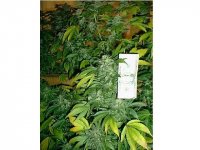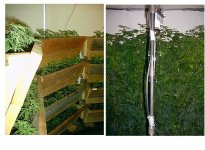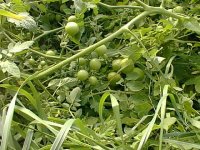There are some who know that I do not agree with everything Elaine Ingham says but overwhelmingly I agree with her concept on growing and nutrient cycling and I admire her work and courage profoundly. Following is something she posted on another forum which I believe is very accurate outside of her math on the amounts of compost per acre. I do not think she will mind me posting it here. I do hope it may help to turn on some lights.
"Re: [compost_tea] Re: Understanding chemcial/biological control of soluble nutrients
In the chemical world, the emphasis has been on what controls taking nutrients from the available form, in solution, to the absorbed form, tied-up on the surfaces of sand, silt, clay, and organic matter.
Plants can only take up the soluble form. Once a nutrient is in a tied-up form, the plant can't get that nutrient.
In the strictly chemical world, the only control on how much nutrient is tied up, or how much is in solution, is knowing something about pH.
But in the real world, you have roots and the food web. What is the action of the soil food web on nutrient cycling?
Another strictly chemical approach that has been brought up, but hasn't worked particularly well in the real world, is to add a soluble form of a salt, something that has a higher affinity for the binding sites on the clays, in order to "knock off" the element in question.
Really stupid way to try to deal with anything, because there is no way to "knock off" just one nutrient. And of course the now soluble salts leach out of your soil. So, not only did you whammy any life in that soil, microbial, plant or otherwise, but you causing a whole herd of some important chemicals to leave the soil, forever gone downstream.
Not too bright.
But in a strictly chemical world, what other ways could you affect nutrient availability or too-much nutrient? OK, pour the nutrients on in high concentration..... we all know that is destroying our ability to have clean water to drink.
Luckily, only in highly controlled lab conditions can anything remain strictly chemical. Life will find a way. Can we speed up biology getting back into really bad conditions? Yep,that's what compost, extract and tea are all about.
Once you add biology back into the mix, that whole pH story gets thrown out the window.
Once you begin to understand that organisms will pull any nutrient off ANY surface, and convert it from one form to another, releasing plant available nutrients, right where the plant needs them, then the whole loading-chemistry-on approach to doing things will be thrown out. Messing with pH is NOT the way to do anything!
Once you realize which organism is really in control of nutrient availability in soil, and which sets of organisms it is controlling, you start to understand that the destruction of soil life that occurs when the strictly chemical approach is used has resulted in the mess our "modern" agriculture is in.
I gave a talk at ACRES USA several years ago on this topic, just when I was beginning to figure out this whole chemistry relationship with biology. I've never spoken at ACRES again, because I upset some people with that talk. It has taken me some time to really work through the whole chemical damage situation. I'm not saying I have it all figured out yet, but I'm getting more of the pieces put together.
In a decent soil, where nutrient cycling hasn't been utterly destroyed, where nutrient holding ability has not been lost, and where compaction issues have not resulted in soil pH down at 3 or 4, you have all the nutrients you need, for MANY years. There is NO NEED to add inorganic fertilizers to most of the cropland in the US. Or Australia. Or South Africa, or any desert, or ....wherever.
There are a few places where the soil has been so utterly destroyed that nutrients really are gone. So looking back at what has happened to your soil in the past is necessary. If you start a program with your closest SFI lab, we go through checking that out with you.
Now, the chemical salesmen always like to say, "But you are removing nutrients everytime you harvest, and therefore, you have to replenish the nutrients you take off".
Now wait, the amount of biomass that is locked up in a forest each year, a healthy forest, is more than the harvested materials removed from most corn fields, or crop field. But the forest isn't running out of nutrients.....the forest keeps growing next year.
Look at the low, low, low nutrient concentrations in most forest soils.
Have some fun with your chemical salesman.....tell them you have a new field and want his recommendation, and send a healthy soil sample in, and watch him go ballistic! You can't possibly grow anything in this soil, you will have to put on tons and tons and tons of nutrient to make this a productive soil.
But the forest is growing more plant material on an annual basis, than is removed from a productive crop field. Explain that. Where are the nutrients coming from in that forest? No one is putting fertilizers on that forest......
Every year, the bedrock breaks down and releases more sand, silt, and clay. The mineral nutrients in your soil are replaced every year because the sand, silt and clay are replenished. Does anyone out there lack bedrock under their soil?
The year you run out of sand, silt and/or clay in your soil is the year you will need to use more compost to replace the nutrients removed in harvest.
1 ton of compost per ac (2.5 tons per hectare then) - properly made, the real stuff, not the putrid,black stuff - co ntains all the nutrients in greater amounts than normal production needs. Make sure you have some N-fixing bacteria in that compost, so maybe an understory of clover or vetch or trefoil or cyanobacteria might be needed to provide N, but between the soil and biology, nutrient cycling supplies everything the plant needs.
The controller of the system, if the right biology is in place, is the plant.
Stop working so hard.
Put your labor force back in place. Balanced for the plant you want.
I try to explain all this, and the way agriculture fell into the chemical place it has been for the last 50 years, in the 3 day intro courses I teach. It has taken awhile to put all this together, and I am sure I don't have all the rough edges polished off yet. People ask me questions and sometimes I have to think about them for awhile. But with thought, and understating how the system works, a few little tests of biology and chemistry working together, and the way it works in a healthy system gets clearer and clearer.
Inorganic fertilizers give really good results IF THE BIOLOGY IS WORKING WELL. There is no need for any inorganic fertilizer if the biology is healthy, and functioning correctly. But, one tillage event too much, one chemical insult too much, and the down ward spiral is on. Lack of nutrition in food, pollution of water, elevated carbon in the atmosphere are a result.
Elaine R. Ingham
President, Soil Foodweb Inc."
"Re: [compost_tea] Re: Understanding chemcial/biological control of soluble nutrients
In the chemical world, the emphasis has been on what controls taking nutrients from the available form, in solution, to the absorbed form, tied-up on the surfaces of sand, silt, clay, and organic matter.
Plants can only take up the soluble form. Once a nutrient is in a tied-up form, the plant can't get that nutrient.
In the strictly chemical world, the only control on how much nutrient is tied up, or how much is in solution, is knowing something about pH.
But in the real world, you have roots and the food web. What is the action of the soil food web on nutrient cycling?
Another strictly chemical approach that has been brought up, but hasn't worked particularly well in the real world, is to add a soluble form of a salt, something that has a higher affinity for the binding sites on the clays, in order to "knock off" the element in question.
Really stupid way to try to deal with anything, because there is no way to "knock off" just one nutrient. And of course the now soluble salts leach out of your soil. So, not only did you whammy any life in that soil, microbial, plant or otherwise, but you causing a whole herd of some important chemicals to leave the soil, forever gone downstream.
Not too bright.
But in a strictly chemical world, what other ways could you affect nutrient availability or too-much nutrient? OK, pour the nutrients on in high concentration..... we all know that is destroying our ability to have clean water to drink.
Luckily, only in highly controlled lab conditions can anything remain strictly chemical. Life will find a way. Can we speed up biology getting back into really bad conditions? Yep,that's what compost, extract and tea are all about.
Once you add biology back into the mix, that whole pH story gets thrown out the window.
Once you begin to understand that organisms will pull any nutrient off ANY surface, and convert it from one form to another, releasing plant available nutrients, right where the plant needs them, then the whole loading-chemistry-on approach to doing things will be thrown out. Messing with pH is NOT the way to do anything!
Once you realize which organism is really in control of nutrient availability in soil, and which sets of organisms it is controlling, you start to understand that the destruction of soil life that occurs when the strictly chemical approach is used has resulted in the mess our "modern" agriculture is in.
I gave a talk at ACRES USA several years ago on this topic, just when I was beginning to figure out this whole chemistry relationship with biology. I've never spoken at ACRES again, because I upset some people with that talk. It has taken me some time to really work through the whole chemical damage situation. I'm not saying I have it all figured out yet, but I'm getting more of the pieces put together.
In a decent soil, where nutrient cycling hasn't been utterly destroyed, where nutrient holding ability has not been lost, and where compaction issues have not resulted in soil pH down at 3 or 4, you have all the nutrients you need, for MANY years. There is NO NEED to add inorganic fertilizers to most of the cropland in the US. Or Australia. Or South Africa, or any desert, or ....wherever.
There are a few places where the soil has been so utterly destroyed that nutrients really are gone. So looking back at what has happened to your soil in the past is necessary. If you start a program with your closest SFI lab, we go through checking that out with you.
Now, the chemical salesmen always like to say, "But you are removing nutrients everytime you harvest, and therefore, you have to replenish the nutrients you take off".
Now wait, the amount of biomass that is locked up in a forest each year, a healthy forest, is more than the harvested materials removed from most corn fields, or crop field. But the forest isn't running out of nutrients.....the forest keeps growing next year.
Look at the low, low, low nutrient concentrations in most forest soils.
Have some fun with your chemical salesman.....tell them you have a new field and want his recommendation, and send a healthy soil sample in, and watch him go ballistic! You can't possibly grow anything in this soil, you will have to put on tons and tons and tons of nutrient to make this a productive soil.
But the forest is growing more plant material on an annual basis, than is removed from a productive crop field. Explain that. Where are the nutrients coming from in that forest? No one is putting fertilizers on that forest......
Every year, the bedrock breaks down and releases more sand, silt, and clay. The mineral nutrients in your soil are replaced every year because the sand, silt and clay are replenished. Does anyone out there lack bedrock under their soil?
The year you run out of sand, silt and/or clay in your soil is the year you will need to use more compost to replace the nutrients removed in harvest.
1 ton of compost per ac (2.5 tons per hectare then) - properly made, the real stuff, not the putrid,black stuff - co ntains all the nutrients in greater amounts than normal production needs. Make sure you have some N-fixing bacteria in that compost, so maybe an understory of clover or vetch or trefoil or cyanobacteria might be needed to provide N, but between the soil and biology, nutrient cycling supplies everything the plant needs.
The controller of the system, if the right biology is in place, is the plant.
Stop working so hard.
Put your labor force back in place. Balanced for the plant you want.
I try to explain all this, and the way agriculture fell into the chemical place it has been for the last 50 years, in the 3 day intro courses I teach. It has taken awhile to put all this together, and I am sure I don't have all the rough edges polished off yet. People ask me questions and sometimes I have to think about them for awhile. But with thought, and understating how the system works, a few little tests of biology and chemistry working together, and the way it works in a healthy system gets clearer and clearer.
Inorganic fertilizers give really good results IF THE BIOLOGY IS WORKING WELL. There is no need for any inorganic fertilizer if the biology is healthy, and functioning correctly. But, one tillage event too much, one chemical insult too much, and the down ward spiral is on. Lack of nutrition in food, pollution of water, elevated carbon in the atmosphere are a result.
Elaine R. Ingham
President, Soil Foodweb Inc."





